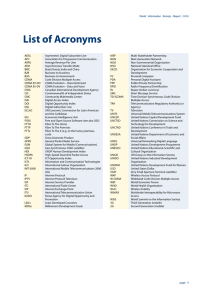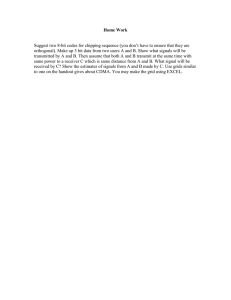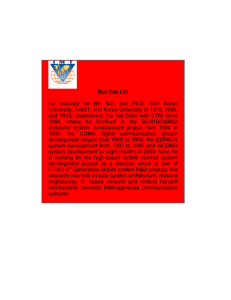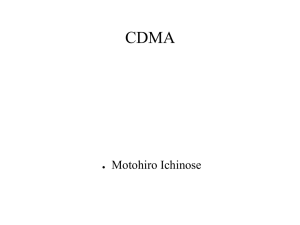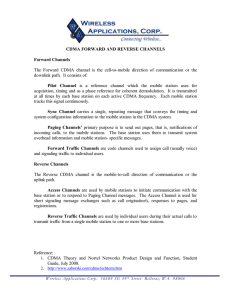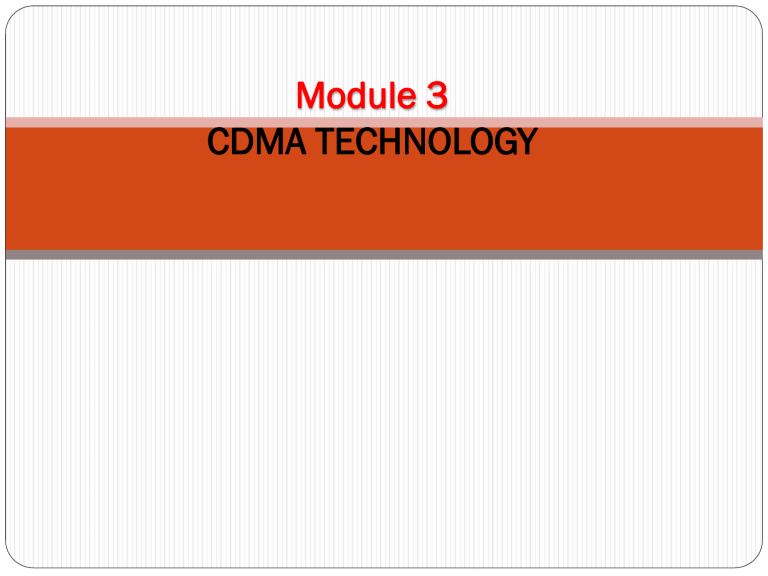
Module 3 CDMA TECHNOLOGY Introduction to CDMA Cellular services are now being used every day by millions of people worldwide. Demand for integration of a variety of multimedia services. The range of services includes short messaging, voice, data, and video. The bit rate required for the services varies widely from 1.2 kbps for paging up to several Mbps for video transmission. supporting such a wide range of data rates with flexible mobility management increases network complexity dramatically. The CDMA is a digital modulation and radio access system that employs signature codes (rather than time slots or frequency bands) to arrange simultaneous and continuous access to a radio network by multiple users. Contribution to the radio channel interference in mobile communications arises from multiple user access, multipath radio propagation, adjacent channel radiation. The spread spectrum system’s performance is relatively immune to radio interference. Cell sectorisation and voice activity used in CDMA radio schemes provide additional capacity compared to FDMA andTDMA. The first cellular CDMA radio system has been constructed in conformity with IS- 95 specifications and is now known commercially as cdmaOne. Evolution of 3G CDMA Cdma2000 Cdma2000 was one of five proposals the ITU approved for IMT-2000 third generation(3G) standards. Provides support for data services up to 2 mbps, multimedia services and advanced radio technologies. 2 phases- 1) 1xRTT( 1X radio transmission technology) happening over a standard 1.25MHz cdma channel. 2) CDMA2000 1xEV (Evolutionary) there are 2 versions– 1xEV-DO(data only) -- 1xEV-DV (Data and Voice) 1XEV –DO support asymmetrical peak data rates of 2.4mbps – downlink and 153 kbps in uplink 1XEV –DV can support integrated voice and data at speeds up to 3mbps over all IP network architecture. CDMA basics: CDMA is a multiple access technology that is based on the use of wideband spread spectrum digital techniques that enable the separation of signals that are concurrent in both time and frequency. All signals share the same frequency spectrum simultaneously. The signals transmitted by the mobile stations and the base stations within the cell are spread over the entire bandwidth of a radio channel and encoded in such a way as to appear as broadband noise signals to every other mobile or base station receiver. The Identification and subsequent demodulation of individual signals occur at a receiver through the use of a copy of the code used to originally spread the signal at the transmitter. This process has the net effect of demodulating the signal intended for the receiver while rejecting all other signals as broadband noise. Since a specific minimum level of signal-to-noise ratio is necessary to provide for a certain level of received signal quality, the level of background noise or interference from all system transmissions ultimately limits the number of users of the system and hence the capacity. comparison of different techniques CDMA Network and System Architecture There is increasing demand for data traffic over mobile radio. The mobile radio industry has to evolve the current radio infrastructures to accommodate the expected data traffic with the efficient provision of high-speed voice traffic. The General Packet Radio Service (GPRS) is being introduced to efficiently support high-rate data over GSM. GPRS signalling and data do not travel through GSM network. The GPRS operation is supported by new protocols and new network nodes: Serving GPRS support node (SGSN) and Gateway GPRS support node (GGSN). One prominent protocol used to tunnel data through IP backbone network is the GPRS tunnel protocol (GTP). GPRS obtains user profile data using location register database of GSM network. GPRS supports quality of service and peak data rate of up to 171.2 kbps with GPRS using all 8 timeslots at the same time. GPRS uses the same modulation as that used in GSM, that is Gaussian Minimum Shift Keying (GMSK) with 4 coding schemes. GPRS packetises the user data and transports it over 1 to 8 radio channel timeslots using IP backbone network. The Enhanced Data Rates for GSM Evolution (EDGE) employs an Enhanced GPRS (EGPRS) to support data rate up to 384 kbps through optimised modulation. Unlike GPRS where header and data are encoded together, headers are encoded separately in EGPRS. EGPRS support 2 modulation schemes, namely GMSK with 4 coding schemes and 8-PSK with 5 coding schemes. Network architecture of CDMA Packet Network architecture of CDMA Mobile- service switching center and visitor location register The CDMA mobile-services switching center (MSC) serves as the interface between the public switched telephone network and base station subsystem. The MSC performs functions necessary for the establishment of calls to and from the system’s mobile subscribers. Provides functionality needed to permit subscriber mobility and roaming. Subscriber registration and authentication, location updating functions, call handoffs and call routing for roaming subscribers. Typically VLR function is colocated with the MSC. Its function is to provide a database containing temporary information about registered subscribers that may be needed by the MSC in the performance of call control operations and the provisioning of subscriber services for the mobiles currently registered In the MSC/VLR service area. Interworking Function: In CDMA system IWF is the only gateway between the wireless network and the PDN. It provides the direct connection to the PDN for packet data calls. The IWF node supports circuit-switched data calls by providing internal modems for connections to dial-up internet service providers(ISPs). These circuit switched data calls are routed to the PSTN through the MSC. The IWF typically uses Ethernet for the signaling between itself and the MSC and for the exchange of packet data between itself and the PDN. In CDMA2000 the IWF’s packet data transfer function is augmented by the packet core network(PCN) element. Mobile Positioning System In CDMA system mobile positioning system can determine the geographic position of a mobile subscriber. MPS is based on Global positioning system(GPS) and is to be used for emergency services. The ability to locate the caller is known as Enhanced 911 or E911. For phase 1 of the wireless E911 program, the cellular system must be able to tell a local public safety answering point (PSAP) the location of the cellular antenna that is handling the emergency call. In phase 2 of the first implementations of this location determining system, the MPS uses a form of mobile-assisted GPS and triangulation to determine the latitude and longitude of the mobile within 50 to 100 meters . Unified Messaging /Voice Mail Service Ericsson Corporation’s new cdma2000 systems contain a unified messaging / voice mail service (UM/VMS) node that integrates e-mail and voice mail access. This node provides messaging waiting indication using short message service (SMS) and multiple message retrieval modes including the use of DTMF or WEB browser. UM/VMS node connects to the PDN and the MSC in Ericsson’s system. HLR/AC The HLR/AC are typically colocated in cdma2000 systems. The HLR holds subscriber information in a database format that is used by the system to manage the subscriber device (SD) activity. The type of information contained in the HLR includes the SD electronic serial number (ESN), details of the subscriber’s service plan, any service restrictions and the identification of the MSC where the mobile was last registered. The AC provides a secure database for the authentication of mobile subscribers when they first register with the system and during call origination and call termination. The AC uses shared secret data (SSD) for authentication calculations. Both the AC and SD calculate SSD based on the authentication key , ESN and random number provided by the AC and broadcast to the SD. The A-key is stored in the SD and also at the AC and never transmitted over the air. The AC or MSC/VLR compares the values calculated by the AC and the SD to determine the mobile’s status with the system. nodes: The prepaid calling service node provides a prepaid calling service using the subscribers home location area MSC. This node provides the MSC with information about the subscriber with account balance information. The PPCS node is usually associated with a prepaid administration computer system that provides the necessary database to store subscriber information and update it as needed. The prepaid administration system (PPAS) provides the subscriber account balance information to the PPCS system. Other additional nodes may be added to the system to provide increased system functionality like intersystem roaming. Base station subsystem: The BSS consists of one BSC and all the radio base stations controlled by the BSC. The BSS provides the mobile subscriber with an interface to the circuit switched core network(PSTN) through the MSC and an interface to public data network (PDN) through the Packet core network(PCN). There can be more than one BSS in a cdma2000 system. The combination of all the CDMA BSS’s and the radio network management system that oversees their operation is known as the CDMA radio access network or C-RAN. BSC It is the interface between the MSC, the packet core network(PCN), other BSSs in the same system, and all of the radio base stations that it controls. It provides routing of data packets between the PCN and the RBSs , radio resource allocation, system timing and synchronization, system power control, all handoff procedures , and processing of both voice and data as needed. RBS The cdma2000 RBS provides the interface between the BSC and the subscriber devices via the common air interface. The functions provided by the RBS include CDMA encoding and decoding of the subscriber traffic and system overhead channels and the CDMA radio links to and from the subscribers. The typical RBS contains an integrated GPS antenna and receiver that is used to provide - system timing and frequency references, - a computer-based control system that monitors and manages the operations of the RBS - provides alarm indications as needed, - communications links for the transmission of both system signals and subscriber traffic between itself and the BSC, and - power supplies and environmental control units as needed. PLMN subnetwork A cdma2000 PLMN provides mobile wireless communication services to subscribers and typically consists of several functional subnetworks. These subnetworks are known as the circuit core network (CCN), Packet core network (PCN), service node network(SSN), and CDMA radio access network (C-RAN) Circuit core network The CCN provides the switching functions necessary to complete calls to and from the mobile subscriber to the PSTN. The major network element in the CCN is the MSC. This portion of the system is primarily concerned with the completion of voice calls between the subscriber and the PSTN. The MSC is basically an extension of the PSTN that services the various cells and associated radio base stations within the cells. The MSC provides circuit switching and provides features such as call charging, subscriber roaming support, and maintenance of subscriber databases. CDMA Radio access network In cdma2000, the CDMA C-RAN provides the interface between the wireless cellular subscriber and CCN. The CCN consists of the MSC and other system components involved with connections to the PSTN for all circuit-switched voice and data calls. The C-RAN can consist of multiple base station subsystems (BSSs) and some form of radio network manager (RNM) system. The RNM system provides operation and management (O&M) support for multiple BSSs. Packet Core Network In cdma2000, the PCN provides a standard interface for wireless packet- switched data service between the C-RAN and public data network(PDN). The PCN provides the necessary links to various IP networks to and from the C-RAN. The PCN typically consists of three main hardware node: - Authentication, authorization and accounting(AAA) - Home agent (HA) - Packet data serving node (PDSN). Packet core Network architecture of CDMA In a cdma2000 cellular system, the packet data serving node (PDSN) provides the needed IP transport capability to connect the C-RAN and hence the subscriber to public data network. The PDSN connects to the C-RAN through the Aquater Interface (also known as the radio-packet R-P interface). The PDSN also interfaces the C-RAN with the home agent and the authentication, authorization and accounting nodes. In such a capacity, it sets up, maintains, and terminates secure communications with the home agent and the authentication, authorization and accounting nodes. It further serves as a point of connection to the radio network and the IP network and provides IP service management to offered IP traffic. Also facilitate wireless mobile IP functionality, it also serves as a foreign agent to register network visitors. The AAA server both authenticates and authorizes the subscriber device to employ the available network services and applications. To facilitate this operation the AAA server manages a database that contains user profiles. The user profile information will also include information about quality of service for the PDSN. The AAA server receives accounting information from the PDSN node that together with session information can be used for billing of the subscriber. An AAA server configured primarily for billing purposes. The PDSN may send accounting information to the billing AAA server and use a different AAA server for authentication and authorization. In cdma2000 system, the home agent (HA) has the task of forwarding all packets that are destined for the subscriber device to the PDSN over an IP network. The PDSN then sends the packets to the SD via the C-RAN and the common air interface. To be able to perform this operation the HA is conjunction with the PDSN authenticates mobile IP registrations from the mobile subscriber, performs SD registration, maintains current location information for the SD , and performs necessary packet tunneling. Packet tunneling: IP packets destined for a perticular SD’s permanent address are rerouted to the SD’s temporary address. If the SD is registered in a foreign network (not its home network) , then the SD has been assigned a temporary dynamic IP address by the foreign agent(this functionality is provided by the foreign network PDSN) and this temporary address is sent to the HA. A recent addition to the elements of the PCN is a wireless LAN serving node(WSN). This node provides IP transport capability and connectivity between the wireless network and wireless LAN enabled subscriber devices through wireless LAN access points. Network interface architecture of CDMA CDMA Channel Concept Forward logical channels The IS-95 CDMA forward channels exist between the CDMA base station and the subscriber devices. IS-95 signal occupies a bandwidth of approximately 1.25 MHz AMPS and NA-TDMA -30 khz Note : refer text book page no:250 to 263 CDMA System operation: Initialization/registration As in case of GSM, CDMA system registration procedures are dependent upon the status of the mobile station. The mobile may be either in a detached condition or in an attached condition. When first turned on, the mobile goes through a power- up state during which it selects a CDMA system and then acquires the pilot and sync channels, which allows it t synchronize its timing to the CDMA system. When attached, the mobile may be in one of three states; mobile station idle state, system access state or mobile station control on the traffic channel state. When in idle state, the mobile monitors the paging channel. In the system access state the mobile station communicates with the CDMA base station, sending and receiving messages. In mobile station control on the traffic channel state the mobile communicates with the base station using the forward and reverse traffic channels while in various traffic channel substates. The mobile may move back and forth between these three states depending upon the movement of the subscriber and the use of the mobile. Registration is the process by which the CDMA mobile station, through messages to the base station, informs the cellular syatem of its identification, location, status, slot cycle for proper and efficient system operation. For slotted mode operation the mobile provides the base station with the SLOT_CYCLE_INDEX value so that the base station may determine which slots the mobile is monitoring. Presently the CDMA system supports ten different forms of registration Power-up Registration: The mobile station registers when it powers on or switches between different band classes or PCS frequency blocks, alternative operating modes, or analog and CDMA operation. Power-down Registration: The mobile registers when it powers off if it has previously registered in the currently serving system. Timer-based registration: The mobile registers whenever various timers expire.This process forces the mobile to register at regular intervals. Distance-based registration: The mobile is forced to register whenever the distance between the current serving base station and the base station where it last registered exceeds a certain threshold. The mobile station calculates this distance by using the latitude and longitude values for the base stations involved. Zone-based registration: The mobile station registers when it enters a new zone. Registration zones are groups of base stations within a particular system and network. Zone registration causes the mobile to register whenever it enters a new zone that is not on its internally stored list of visited registration zones. These five modes of registration are known as autonomous registration and are enabled by roaming status. Parameter – change registration: The mobile station registers when specific parameters stored in its memory change or when it enters a new system. This form of registration is independent of roaming status. Ordered registration: The mobile station registers when requested to by the base station through the issue of an order message. Implicit registration: Whenever the mobile station successfully sends an origination message or a page response message, the base station is able to deduce the location of the mobile. These circumstances are considered to constitute an implicit registration. Traffic channel registration: Whenever a base station has registration information for a mobile that has been assigned to a traffic channel, the base station may notify the mobile that it is registered. User zone registration : Whenever the mobile selects an active user zone, it registers. Call Handoff Idle/access handoff Soft handoff - Softer handoff - soft handoff - soft softer handoff Hard handoff Note :refer text book page no:275 to 282 The specification for IS-95 CDMA depends on three mobile station states during which a handoff can occur. These three states are the idle state, access state, and traffic state. The procedures used and the type of handoff performed will depend upon the mobiles present state. In all the cases, the handoffs are mobile assisted since the mobile station is tasked with reporting signal-strength measurements of various pilot channels to the network. Handoff occurs when the serving sector/cell is no longer capable of supporting communications between the mobile and itself. CDMA is unique in that it supports soft/softer handoffs. There are several advantages to this type of handoff including improved system performance for the support of voice traffic calls and the support of high-speed data transfers. Idle/ Access Handoff : If the mobile is in the idle state and moves from the coverage area of one sector/cell into another sector/cell, an idle handoff can occur. When the RSS of a different pilot channel is determined to be twice as strong than the current PC, the mobile will start listening to the paging channel associated with the stronger PC. This type of handoff is considered a form of hard handoff since there is a brief interruption of the communication link. But it is certainly different from and less disrupting than a hard handoff that might occur when the mobile is in the traffic mode. While the mobile is in the access state, it can also perform a handoff. An access entry handoff allows the mobile to perform a hard idle handoff from one paging channel to another in the best signal-strength sector/cell just after the mobile enters the access state. Soft Handoff: A soft handoff occurs when the mobile is able to communicate simultaneously with several new cells or a new sector of the current cell over a forward traffic channel (FTC) while still maintaining communications over the FTC of the current cell or sector. The mobile station can only perform a soft handoff while in the traffic state to a new cell or sector that has the same frequency carrier. The use of soft handoffs is associated with the near-far problem and the associated power control mechanism used in CDMA systems. If a mobile moves away from base station and continually increases its output power to compensate for the signal attenuation encountered at the greater distance, it will cause a great deal of interference to mobiles in neighboring cells and raise the level of background noise in its own cell. To overcome this problem and to make sure that the mobile is connected to the base station with the greatest RSS, a strategy employing soft handoffs has been designed into CDMA wireless mobile system. In theory, the optimal CDMA system operation will occur when each mobile is connected to the nearest base station and is transmitting with the lowest output power necessary for proper operation. The use of soft handoff can actually improve system performance since the procedure used can actually lower reverse link output power because the received signal from several base stations can be combined. The soft handover process can enhance system performance by increasing call quality, improving coverage and increasing capacity. Softer handoff: handoff is between two sectors of the same cell. Soft handoff: can occurs between two different cells. Soft-softer handoff: can occur when the motion of the mobile gives it a handoff choice between two sectors of the same cell and a sector from an adjacent cell. Hard Handoff: A CDMA mobile in the traffic state can experience a hard handoff. This will occur for the case of an intercarrier handoff. Intercarrier handoff causes the radio link to be abruptly interrupted for a short period
